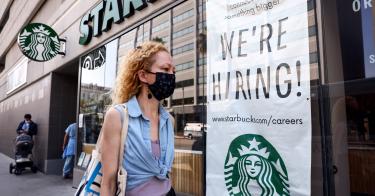Between out-of-control inflation, ongoing supply-chain struggles, the crisis at the southern border, foreign policy concerns, exploding energy prices, rising crime, and a high likelihood that the country is either already or soon will be experiencing stagflation (an inflationary recession), it’s no wonder that Democrats and the Biden administration are talking up the strong labor market.
A recent tweet on the Democrats official Twitter page stated, “Under @JoeBiden, the private sector has recovered all of the jobs lost during the pandemic—and added jobs on top of that.”
For starters, that statement is only half-true, at best.
According to the official jobs numbers from the Bureau of Labor Statistics, private-sector jobs are up by about 140,000 since the low in April 2020, but only four in 10 of those job gains occurred on the Biden administration’s watch, while six in 10 were recovered during the Trump administration.
>>>What Is Happening in This Unprecedented U.S. Labor Market? July 2022 Update
But that’s just private-sector jobs. There are 755,000 fewer people employed today than at the start of the pandemic, despite a 4.2 million increase in the population of people ages 16 and older.
If the employment-to-population ratio were the same as it was prior to the pandemic, in February 2020, 3.3 million more people would be working today. Moreover, economists estimate that a decline in the desired hours of work has roughly doubled the magnitude of the labor force decline.
While the labor market appears to be going well by some metrics, that’s not the whole story.
Metrics like a near-half-century-low unemployment rate, high nominal wage gains, and 11.3 million job openings that equal two jobs available for every unemployed person didn’t arise naturally. Rather, they were artificially induced through bad government policies that have included a lot of unintended consequences.
Most significantly, 18-months’ worth of bonus unemployment benefits that paid most people more to stay on the sidelines than to work caused millions of people to leave the labor market. Meanwhile, Washington stimulated consumer and business demand for goods and services by flooding the economy with trillions of dollars in so-called COVID-19 relief—about half of which was money printed by the Federal Reserve.
The unprecedented labor shortage has caused huge struggles for employers, and all sorts of problems for ordinary Americans, including cancelled flights, unopened community pools, delayed deliveries, over-crowded emergency rooms, and reduced public safety.
Too few workers is also adding to the inflationary cycle.
When employers have to compete for workers, they have to increase their compensation. According to the National Federation of Independent Businesses (NFIB) survey, 48 percent of owners reported increasing compensation in June and 28 percent said they plan to increase compensation over the next three months.
>>>Apprenticeships, Not College, Can Help Reduce Unemployment
But paying workers more to do the exact same thing requires hiking prices, and as the NFIB report states, “These rising labor costs will be passed on to consumers through higher selling prices, which are being raised at a record pace,” with 69 percent of employers reporting increased prices in June.
Yet, despite a $3,100 increase in the average full-time worker’s paycheck over the past year, inflation has eaten away $5,300 of value, leaving him $2,200 poorer.
And the future isn’t looking good. Small business owners’ expectations for better business conditions reached an all-time low in June, owing to “inflation and worker shortages,” along with “policy talks that [have] shifted to tax increases and more regulations.”
Government policies to spend more, tax more, regulate more, and produce less will only make labor shortages and inflation worse.
If lawmakers want to be able to tout metrics like increased labor force participation and real rising wages, they should start by removing the government-imposed barriers they’ve created for work and productivity.
This piece originally appeared in The Sacramento Bee




